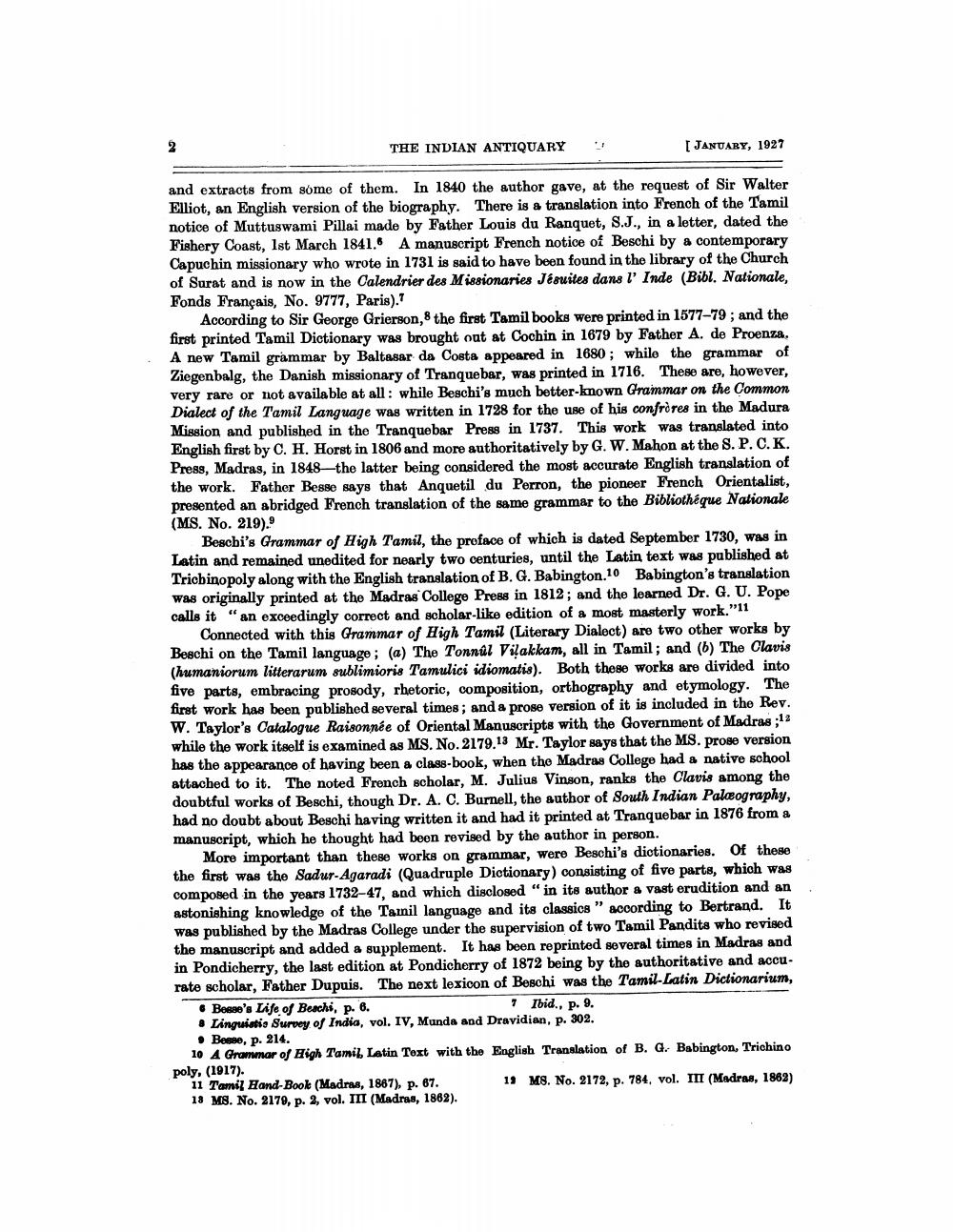________________
THE INDIAN ANTIQUARY
[ JANUARY, 1927
and extracts from some of them. In 1840 the author gave, at the request of Sir Walter Elliot, an English version of the biography. There is a translation into French of the Tamil notice of Muttuswami Pillai made by Father Louis du Ranquet, S.J., in a letter, dated the Fishery Coast, 1st March 1841.6 A manuscript French notice of Beschi by a contemporary Capuchin missionary who wrote in 1731 is said to have been found in the library of the Church of Surat and is now in the Calendrier des Missionaries Jésuites dans l'Inde (Bibl. Nationale, Fonds Français, No. 9777, Paris).
According to Sir George Grierson, the first Tamil books were printed in 1577-79; and the first printed Tamil Dictionary was brought out at Cochin in 1679 by Father A. de Proenza. A new Tamil grammar by Baltasar da Costa appeared in 1680; while the grammar of Ziegenbalg, the Danish missionary of Tranquebar, was printed in 1716. These are, however, very rare or not available at all: while Beschi's much better known Grammar on the Common Dialect of the Tamil Language was written in 1728 for the use of his confrères in the Madura Mission and published in the Tranquebar Press in 1737. This work was translated into English first by C. H. Horst in 1806 and more authoritatively by G. W. Mahon at the S.P.C.K. Press, Madras, in 1848—the latter being considered the most accurate English translation of the work. Father Besse says that Anquetil du Perron, the pioneer French Orientalist, presented an abridged French translation of the same grammar to the Bibliothéque Nationale (MS. No. 219).
Beschi's Grammar of High Tamil, the proface of which is dated September 1730, was in Latin and remained unedited for nearly two centuries, until the Latin text was published at Trichinopoly along with the English translation of B. G. Babington.10 Babington's translation was originally printed at the Madras College Press in 1812; and the learned Dr. G. U. Pope calls it "an exceedingly correct and scholar-like edition of a most masterly work."11
Connected with this Grammar of High Tamil (Literary Dialect) are two other works by Beschi on the Tamil language; (a) The Tonnúl Vilakkam, all in Tamil; and (6) The Clavis (humaniorum litterarum sublimioris Tamulici idiomatis). Both these works are divided into five parts, embracing prosody, rhetoric, composition, orthography and etymology. The first work has been published several times; and a prose version of it is included in the Rev. W. Taylor's Catalogue Raisonnée of Oriental Manuscripts with the Government of Madras ;12 while the work itself is examined as MS. No. 2179.13 Mr. Taylor says that the MS. Prose version has the appearance of having been a class-book, when the Madras College had a native school attached to it. The noted French scholar, M. Julius Vinson, ranks the Clavis among the doubtful works of Beschi, though Dr. A. C. Burnell, the author of South Indian Paleography, had no doubt about Beschi having written it and had it printed at Tranquebar in 1876 from a manuscript, which he thought had been revised by the author in person.
More important than these works on grammar, were Beschi's dictionaries. Of these the first was the Sadur-Agaradi (Quadruple Dictionary) consisting of five parts, which was composed in the years 1732-47, and which disclosed " in its author a vast erudition and an astonishing knowledge of the Tamil language and its classics " according to Bertrand. It was published by the Madras College under the supervision of two Tamil Pandits who revised the manuscript and added a supplement. It has been reprinted several times in Madras and in Pondicherry, the last edition at Pondicherry of 1872 being by the authoritative and accurate scholar, Father Dupuis. The next lexicon of Beschi was the Tamil-Latin Dictionarium, 6 Besse's Life of Beachi, p. 6.
1 Ibid., p. 9. • Linguistia Survey of India, vol. IV, Munda and Dravidian, p. 302.
Besse, p. 214. 10 A Grammar of High Tamil, Latin Text with the English Translation of B. G. Babington, Trichino poly, (1917). 11 Tamil Hand-Book (Madras, 1867), p. 67.
11 M8. No. 2172, p. 784, vol. III (Madras, 1862) 18 MS. No. 2179, p. 2, vol. III (Madras, 1862).




